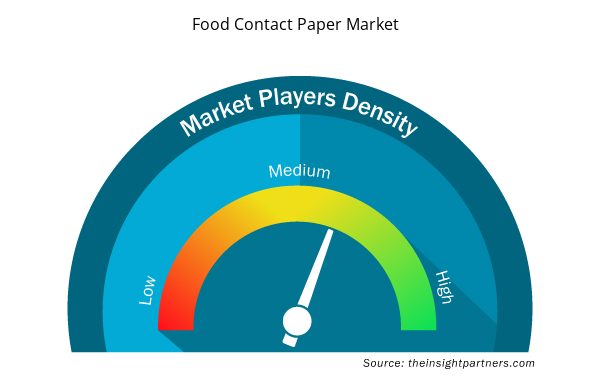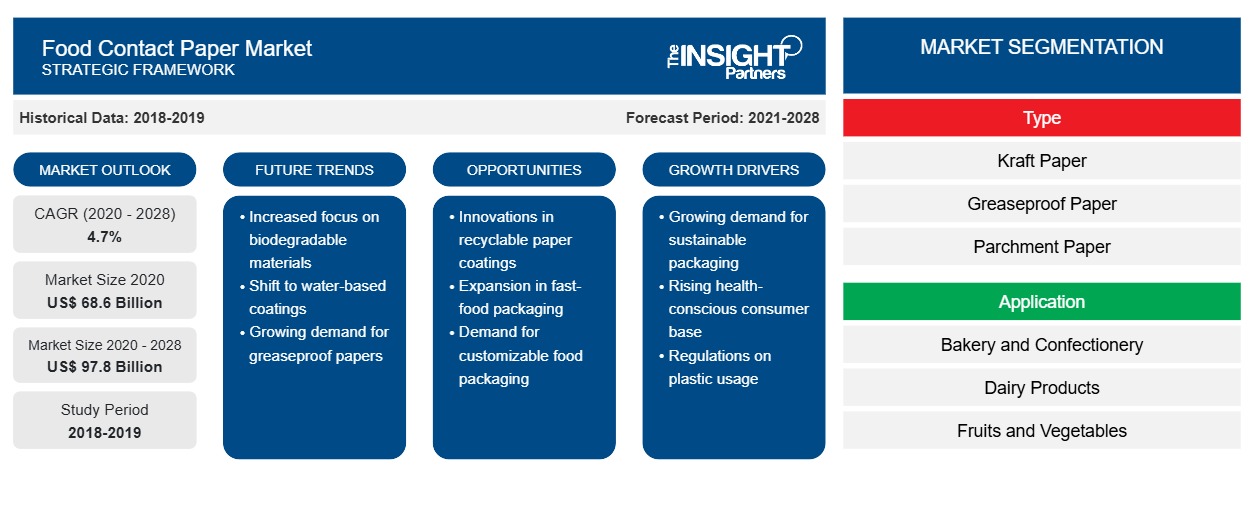2020 年食品接触纸市场价值为 686 亿美元,预计到 2028 年将达到 978 亿美元;预计 2021 年至 2028 年的复合年增长率为 4.7%。
食品接触纸是各种食品的主要包装材料,例如烘焙食品、糖果、肉类、零食和谷物磨制产品。这些纸是许多其他食品包装材料(例如塑料和玻璃)的可持续替代品。越来越多的公司采取减少碳足迹的举措,影响着世界各地对食品接触纸的采用。对可持续和环保食品包装的需求增加也增加了对食品纸包装的需求。
2020 年,亚太地区在全球食品接触纸市场占据主导地位,预计在预测期内将继续保持主导地位。亚洲国家餐饮业的不断发展、环保意识的提高、亚洲多个国家政府出台的塑料包装禁令,预计将加速对环保和可持续包装解决方案的需求,从而推动亚太地区食品接触纸市场的增长。
定制此报告以满足您的需求
您可以免费定制任何报告,包括本报告的部分内容、国家级分析、Excel 数据包,以及为初创企业和大学提供优惠和折扣
- 获取此报告的关键市场趋势。这个免费样品将包括数据分析,从市场趋势到估计和预测。
由于 COVID-19 疫情,许多行业(例如化学品和材料行业)都面临前所未有的挑战。由于原材料和劳动力短缺、工厂关闭以及 COVID-19 安全协议下的其他运营困难,包装产品制造商在疫情爆发的最初几个月面临销售萎缩。此外,由于病毒传播,消费者生活方式和饮食习惯的转变减少了即食食品和外食的消费,这对食品接触纸的需求产生了负面影响。然而,随着一些国家采取适当的预防措施解除封锁,食品接触纸的需求可能会恢复正常。随着各国实施封锁,由于线下商店关闭,电子商务行业对各种产品的需求大幅增加,例如包装食品和包括新鲜蔬菜和水果在内的杂货,这刺激了食品接触纸的使用。
市场洞察
对可回收和可生物降解包装解决方案的需求不断扩大
对于消费者和制造商来说,可生物降解和可回收的包装一直是一次性包装的有吸引力的替代品。食品服务包装在美国的垃圾填埋场产生了大量垃圾。根据美国环境保护署发布的一份报告,食品垃圾和包装占美国垃圾填埋场的大部分。由于纸质包装是可生物降解的,因此比可回收包装更受欢迎。使用可回收食品包装会增加污染的可能性,从而可能影响环境和人类健康。世界各国政府越来越多地采取举措,减少一次性塑料袋的使用,推动了对可回收且可持续的包装解决方案的需求,从而导致对食品接触纸的需求增加。
类型洞察
根据类型,食品接触纸市场细分为牛皮纸、防油纸、羊皮纸等。牛皮纸部分在 2020 年占据了最大的市场份额。天然牛皮纸具有纯原生纤维,使其成为理想的食品接触包装解决方案。这种纸越来越多地用于制造各种食品接触纸产品,例如纸袋、纸袋、包装纸和纸盘。天然牛皮纸由于其强度高,也越来越多地用于制作新鲜水果和蔬菜的购物袋。
Mondi;Westrock Company;Georgia-Pacific LLC;Twin River Paper Company;UPM;Ahlstrom-Munksjö;GM Packaging (UK) Ltd;Superiorpaper Pty Ltd. TopCare;以及 KRPA Holding CZ,这些是食品接触纸市场的主要参与者。主要市场参与者正在采用并购和产品发布等策略来扩大其地理覆盖范围和消费者基础。
报告亮点
- 食品接触纸行业的进步趋势,帮助参与者制定有效的长期战略
- 公司采用的业务增长战略来确保发达市场和发展中市场的增长
- 2019 年至 2028 年全球食品接触纸市场定量分析
- 各行业对食品接触纸的需求估计
- 波特分析说明了行业内买家和供应商预测市场增长的有效性
- 了解竞争激烈的市场形势和食品接触纸的需求的最新发展
- 市场趋势和前景以及推动和抑制食品接触纸市场增长的因素
- 了解全球食品接触纸市场增长的商业利益背后的战略,有助于决策过程
- 浮法玻璃市场各节点规模
- 全球食品接触纸市场的详细概述和细分以及其行业动态
- 各地区食品接触纸市场规模及增长机遇
食品接触纸市场区域洞察
Insight Partners 的分析师已详尽解释了预测期内影响食品接触纸市场的区域趋势和因素。本节还讨论了北美、欧洲、亚太地区、中东和非洲以及南美和中美洲的食品接触纸市场细分和地理位置。

- 获取食品接触纸市场的区域特定数据
食品接触纸市场报告范围
| 报告属性 | 细节 |
|---|---|
| 2020 年市场规模 | 686亿美元 |
| 2028 年市场规模 | 978亿美元 |
| 全球复合年增长率(2020 - 2028) | 4.7% |
| 史料 | 2018-2019 |
| 预测期 | 2021-2028 |
| 涵盖的领域 | 按类型
|
| 覆盖地区和国家 | 北美
|
| 市场领导者和主要公司简介 |
|
食品接触纸市场参与者密度:了解其对业务动态的影响
食品接触纸市场正在快速增长,这得益于终端用户需求的不断增长,而这些需求又源于消费者偏好的不断变化、技术进步以及对产品优势的认识不断提高等因素。随着需求的增加,企业正在扩大其产品范围,进行创新以满足消费者的需求,并利用新兴趋势,从而进一步推动市场增长。
市场参与者密度是指在特定市场或行业内运营的企业或公司的分布情况。它表明在给定市场空间中,相对于其规模或总市场价值,有多少竞争对手(市场参与者)存在。
在食品接触纸市场运营的主要公司有:
- 蒙迪
- 韦斯特洛克公司
- 乔治亚太平洋有限责任公司
- 双河纸业公司
- 芬欧汇川
免责声明:上面列出的公司没有按照任何特定顺序排列。

- 了解食品接触纸市场主要参与者概况
食品接触纸市场,按类型
- 牛皮纸
- 防油纸
- 羊皮纸
- 其他的
食品接触纸市场,按应用划分
- 面包和糖果
- 乳制品
- 水果和蔬菜
- 肉类、鱼类和家禽
- 其他的
公司简介
- 蒙迪
- 韦斯特洛克公司
- 乔治亚太平洋有限责任公司
- 双河纸业公司
- 芬欧汇川
- 奥斯龙-明克斯乔
- GM 包装(英国)有限公司
- Superiorpaper 有限公司
- 顶级护理
- KRPA Holding CZ,作为
- 历史分析(2 年)、基准年、预测(7 年)及复合年增长率
- PEST 和 SWOT 分析
- 市场规模价值/数量 - 全球、区域、国家
- 行业和竞争格局
- Excel 数据集



Report Coverage
Revenue forecast, Company Analysis, Industry landscape, Growth factors, and Trends

Segment Covered
This text is related
to segments covered.

Regional Scope
North America, Europe, Asia Pacific, Middle East & Africa, South & Central America

Country Scope
This text is related
to country scope.
常见问题
Based on application, the global food contact paper market is segmented into bakery and confectionery, dairy products, fruits and vegetables, meat fish and poultry, and others. In 2020, the bakery and confectionery segment accounted for a significant revenue share. The food contact paper is being increasingly used in the bakery and confectionery sector which includes the usage of parchment paper in baking as it is heat-resistant and provides a non-stick surface to bake on. The common use of parchment paper is to eliminate the need for grease sheet pans and also allows a very rapid turnaround of batches of baked goods with minimal clean-up. Greaseproof paper is also an ideal solution for bakery items as it is able to withstand a wide range of environments, from hot oven to deep freezer & humidity.
On the basis of type, the greaseproof paper segment held the fastest CAGR in the food contact paper market for the forecast period. The paper is used for wrapping food items such as sandwiches, cheese, desserts, baked goods, and cold meats. The greaseproof paper will help in providing a grease-free method for transporting and handling oily foods. These papers are also recyclable as well as printable. The greaseproof paper is permeable to air and moisture, which makes it possible for the food inside the paper to breathe and steam and exhale excess moisture.
The fruit and vegetable segment is expected to grow at the fastest rate during the forecast period. There has been an increase use of kraft paper in various food contact paper packaging solutions for fruits and vegetables. It is being used as a vegetable box which is used for packaging and shipping of the vegetables and fruits as well as is used to produce embossed paper cushion pads for the packaging of vegetables and fresh fruit. Along with this, wax paper is also used for storing fruits and vegetables as the moisture retention capabilities of wax paper will keep the fruits and vegetables fresh for a longer period of time and will slow down their ripening and spoilage rate.
Kraft paper is basically a paper or paperboard which is being produced from the chemical pulp through kraft papers. The natural kraft papers have pure virgin fibers which makes it an ideal food contact packaging solution. Kraft paper is being increasingly used for manufacturing various food contact papers including paper bags, paper sacks, wrapping paper, and paper plates. Natural kraft paper is also being increasingly used as a grocery bag for fresh fruits and vegetables which is due to its high strength.
The major key players operating in the global food contact paper market include Mondi; Westrock Company; Georgia-Pacific LLC; Twin River Paper Company; UPM; Ahlstrom-Munksjö; GM Packaging (UK) Ltd; Superiorpaper Pty Ltd. TopCare; and KRPA Holding CZ, a.s and SK Hynix Inc.
The Asia Pacific dominated the global market. The region is expected to continue its dominance during the forecast period. The growing market penetration of the foodservice industry in recent years in the Asian countries is estimated to accelerate the food contact paper market growth in this region during the forecast period. Along with this, an increase in awareness about the environment is expected to result in increased demand for greener packaging solutions. Various initiatives taken by the government to ban plastic packaging in several Asian countries are also expected to accelerate the demand for eco-friendly and sustainable packaging solutions, which will increase the demand for food contact paper in the Asia Pacific. Along with this, the increasing presence of domestic and international players in the market has led to an increased focus of product quality and innovation, which will provide growth opportunities for the food contact paper market.
Trends and growth analysis reports related to Chemicals and Materials : READ MORE..
The List of Companies - Food Contact Paper Market
- Mondi
- Westrock Company
- Georgia-Pacific LLC
- Twin River Paper Company
- UPM
- Ahlstrom-Munksjö
- GM Packaging (UK) Ltd
- Superiorpaper Pty Ltd
- TopCare
- KRPA Holding CZ, a.s.
The Insight Partners performs research in 4 major stages: Data Collection & Secondary Research, Primary Research, Data Analysis and Data Triangulation & Final Review.
- Data Collection and Secondary Research:
As a market research and consulting firm operating from a decade, we have published and advised several client across the globe. First step for any study will start with an assessment of currently available data and insights from existing reports. Further, historical and current market information is collected from Investor Presentations, Annual Reports, SEC Filings, etc., and other information related to company’s performance and market positioning are gathered from Paid Databases (Factiva, Hoovers, and Reuters) and various other publications available in public domain.
Several associations trade associates, technical forums, institutes, societies and organization are accessed to gain technical as well as market related insights through their publications such as research papers, blogs and press releases related to the studies are referred to get cues about the market. Further, white papers, journals, magazines, and other news articles published in last 3 years are scrutinized and analyzed to understand the current market trends.
- Primary Research:
The primarily interview analysis comprise of data obtained from industry participants interview and answers to survey questions gathered by in-house primary team.
For primary research, interviews are conducted with industry experts/CEOs/Marketing Managers/VPs/Subject Matter Experts from both demand and supply side to get a 360-degree view of the market. The primary team conducts several interviews based on the complexity of the markets to understand the various market trends and dynamics which makes research more credible and precise.
A typical research interview fulfils the following functions:
- Provides first-hand information on the market size, market trends, growth trends, competitive landscape, and outlook
- Validates and strengthens in-house secondary research findings
- Develops the analysis team’s expertise and market understanding
Primary research involves email interactions and telephone interviews for each market, category, segment, and sub-segment across geographies. The participants who typically take part in such a process include, but are not limited to:
- Industry participants: VPs, business development managers, market intelligence managers and national sales managers
- Outside experts: Valuation experts, research analysts and key opinion leaders specializing in the electronics and semiconductor industry.
Below is the breakup of our primary respondents by company, designation, and region:

Once we receive the confirmation from primary research sources or primary respondents, we finalize the base year market estimation and forecast the data as per the macroeconomic and microeconomic factors assessed during data collection.
- Data Analysis:
Once data is validated through both secondary as well as primary respondents, we finalize the market estimations by hypothesis formulation and factor analysis at regional and country level.
- Macro-Economic Factor Analysis:
We analyse macroeconomic indicators such the gross domestic product (GDP), increase in the demand for goods and services across industries, technological advancement, regional economic growth, governmental policies, the influence of COVID-19, PEST analysis, and other aspects. This analysis aids in setting benchmarks for various nations/regions and approximating market splits. Additionally, the general trend of the aforementioned components aid in determining the market's development possibilities.
- Country Level Data:
Various factors that are especially aligned to the country are taken into account to determine the market size for a certain area and country, including the presence of vendors, such as headquarters and offices, the country's GDP, demand patterns, and industry growth. To comprehend the market dynamics for the nation, a number of growth variables, inhibitors, application areas, and current market trends are researched. The aforementioned elements aid in determining the country's overall market's growth potential.
- Company Profile:
The “Table of Contents” is formulated by listing and analyzing more than 25 - 30 companies operating in the market ecosystem across geographies. However, we profile only 10 companies as a standard practice in our syndicate reports. These 10 companies comprise leading, emerging, and regional players. Nonetheless, our analysis is not restricted to the 10 listed companies, we also analyze other companies present in the market to develop a holistic view and understand the prevailing trends. The “Company Profiles” section in the report covers key facts, business description, products & services, financial information, SWOT analysis, and key developments. The financial information presented is extracted from the annual reports and official documents of the publicly listed companies. Upon collecting the information for the sections of respective companies, we verify them via various primary sources and then compile the data in respective company profiles. The company level information helps us in deriving the base number as well as in forecasting the market size.
- Developing Base Number:
Aggregation of sales statistics (2020-2022) and macro-economic factor, and other secondary and primary research insights are utilized to arrive at base number and related market shares for 2022. The data gaps are identified in this step and relevant market data is analyzed, collected from paid primary interviews or databases. On finalizing the base year market size, forecasts are developed on the basis of macro-economic, industry and market growth factors and company level analysis.
- Data Triangulation and Final Review:
The market findings and base year market size calculations are validated from supply as well as demand side. Demand side validations are based on macro-economic factor analysis and benchmarks for respective regions and countries. In case of supply side validations, revenues of major companies are estimated (in case not available) based on industry benchmark, approximate number of employees, product portfolio, and primary interviews revenues are gathered. Further revenue from target product/service segment is assessed to avoid overshooting of market statistics. In case of heavy deviations between supply and demand side values, all thes steps are repeated to achieve synchronization.
We follow an iterative model, wherein we share our research findings with Subject Matter Experts (SME’s) and Key Opinion Leaders (KOLs) until consensus view of the market is not formulated – this model negates any drastic deviation in the opinions of experts. Only validated and universally acceptable research findings are quoted in our reports.
We have important check points that we use to validate our research findings – which we call – data triangulation, where we validate the information, we generate from secondary sources with primary interviews and then we re-validate with our internal data bases and Subject matter experts. This comprehensive model enables us to deliver high quality, reliable data in shortest possible time.


 获取此报告的免费样本
获取此报告的免费样本